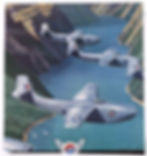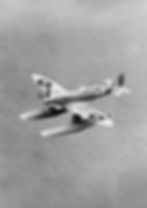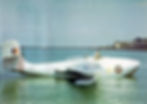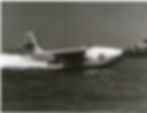Our Experimental Jet Flying Boat - the Saunders Roe SRA/1
- Captain Crisp
- Mar 25, 2020
- 7 min read

0530 15 September 1950 – HMS Unicorn, off Inchon, Korea.
Lt Cdr Al Jones, CO of 848 FAA Squadron, signals for engine starts on his squadron’s twelve SR.A/1 ‘Harpy’ jet fighters ready to lead them on a bombing and straffing mission in support of the US landings on the Inchon peninsula at the height of the Korean War. Twenty four ‘Beryl’ [named after the semi-precious stone] turbojets begin their snarling whine.
What makes them special is that these fighters aren’t flying off the carrier’s deck, but are floating on the sea - attached to the carrier by extended booms alongside – these fighters are the world’s first jet flying boat fighters, going into action for the first time…..
During the Second World War, the Pacific Theatre saw the introduction, particularly by the Japanese, of floatplane variants of existing fighter aircraft. Not such a strange idea, as the pacific was a vast ocean with [especially closer to Japan] clusters of small islands.
The gradual conquest of these islands was necessary to build large enough airstrips in addition to the already constructed Japanese ones to accommodate US bombers to attack Japan.

This mobile campaign made the UK and US look at the Japanese use of floatplane fighters anew. There were obvious advantages to have a water-borne fighter in the Pacific – no prepared airfields were needed, just sheltered inlets and coves which were invulnerable to enemy attacks unlike land airfields and runways. Britain had toyed with and discarded the concept of a floatplane fighter after a few prototypes of Spitfire floatplanes were built, while the US, although having several general purpose floatplanes, had not built any true floatplane fighters.

In 1943, the new jet engine technology made one company in particular – Saunders-Roe, based on the Isle of Wight – look at the problem. They reasoned that this new engine when placed in a waterborne fighter would have the edge over an enemy piston engine powered one – and would be ideal for the Pacific. The aircraft would be designed as a flying boat rather than a floatplane, which would reduce weight and drag, give better aerodynamics and just as importantly better fuel efficiency.
Although Saunders-Roe were well known for their previous flying boat work, they were blessed with the arrival at this time by Sir Arthur Gouge from their main rivals – Short Brothers. Gouge had been chief designer at Shorts, and brought his considerable expertise to Saunders-Roe, and in particular to this project.
The company very quickly began consultation with the Metropolitan Vickers Gas Turbine department who were already testing their engines in a couple of the new jet prototype Thunderbolts – this aircraft was very quickly renamed the Meteor to avoid confusion with the US piston engine fighter - with the first ‘MetroVick’ powered versions flying in November 1943.

This joint enterprise allowed Saunders-Roe to submit their proposal for a coastal jet flying boat fighter to the MAP by December 1943 – MAP liked the concept and after a few further discussions and amendment gave Saunders-Roe a contract in May 1944 under specification E.6/44 to build prototype aircraft.
Other war work was fairly obviously a priority, so the design was initially undertaken at the Beaumaris, Anglesey factory until the end of the war when all design and development moved back to Cowes.
Although the aircraft had been designed for the Pacific war, there were understandable delays in the new engine development, linked with much investigation into hull design to not only accommodate two jet engines [two were thought to be required as the existing jet engines gave fairly low power] but to limit water ingress into air intakes.
The aircraft was designed from the start to operate in coastal regions or close to islands, rather than an open sea aircraft, thus making the hull design actually easier. By May 1946, three aircraft were being assembled at Cowes, using parts also made at Eastleigh and Beaumaris, with the actual testing to be at Cowes.

The ‘Squirt’ as the aircraft was colloquially known to the workforce, was designed around two side by side MetroVick F24 ‘Beryl’ axial flow turbojets [axial flow giving a narrow diameter than the existing British centrifugal flow jets], an engine that had been first run in January 1945.
The aircraft had a high nose air intake to stop any water ingress, with the exhaust for each engine either side of the hull angled at 5 degrees to clear the hull. Above the intake were to be four Hispano 20mm cannon, outwardly retractable wing floats were fitted, with provision for either 141 gallon fuel tanks or up to a total of eight rockets or a 1000lb bomb under each wing near the wing root.
Performance wise, the aircraft was projected to have a maximum speed of 500 mph; service ceiling of 43,000ft; endurance without overload tanks of 1hr 48mins. Coupled with the armament options, this seemed to be a potent aircraft indeed.
Although Saunders-Roe had originated the concept of a jet waterborne fighter, by this time the odds were against them actually producing the aircraft.

The war was now over, therefore the perceived Pacific War use was non-existent, and no firm orders beyond the three prototypes had been received; rapid developments in jet engine and fighter technology meant that the ‘Squirt’, as the workforce nicknamed the aircraft, would [literally] lag behind fighters entering service at the same projected time; the support mechanism – the need for seaplane carriers or submarines and servicing and replenishment ships would increase the costs beyond equivalent land based aircraft; and finally, Britain had entered a period of extreme austerity with dramatic cuts in defence spending.
Still, work continued, with the first of the three aircraft, TG263, making her maiden flight on 16 July, 1947 with Geoffrey Tyson at the helm. Apart from a few small changes, the aircraft was deemed successful enough to be exhibited in the flying display of the SBAC show only two months later.
The other two aircraft, TG267 and TG271 made their first flights on 30 April 1948 and 17 August 1948 respectfully with uprated Beryl engines. Tyson made his famous flypast inverted at low level in TG271 at the 1948 SBAC show only one month after her first flight!
Sadly, both TG267 and TG271 were lost in accidents the following year – TG267 in August 1949 when the famous ‘Winkle’ Brown hit a half-submerged object on landing off Cowes. The aircraft sank, almost taking Brown with it, but Geoffrey Tyson, watching from a nearby support boat, dived in to the sea to pull his unconscious friend from the water.

The second aircraft, TG271, was being flown by Sqn Ldr Major off Felixstowe in September 1949 was practising for an air show when it dived into the sea and broke up, killing the pilot.
These accidents slowed the development programme, further complicated by the fact that MetroVick had passed their gas turbine designs to Armstrong Siddley as the aviation industry under austerity was contracting, and they did not continue production of the Beryl. Had Saunders-Roe secured firm orders for the aircraft, the lack of a suitable engine would have been almost be insurmountable.
So the first aircraft, TG263, languished in store until November 1950.
The onset of the Korean War with the potential requirement for a flying boat fighter given the location of the conflict meant that the ‘Squirt’ was dusted off and looked at anew.

It was considered whether to re engine any subsequent ordered SR.A/1’s with a single Sapphire 3 turbojet, but this would have required a time-consuming complete redesign of the hull/fuselage – hardly practical when no orders had been received – so the idea immediately died.
TG263 was again dusted off and flown by Geoffrey Tyson up the Thames to London as part of the Festival of Britain celebrations in June 1951, wearing ‘civilian clothes’ of G-12-1 instead of her roundels. Tyson got into the aircraft for the return to Cowes, only to find that a tall ships regatta had arrived, making his take off run down the Thames a little more interesting than usual! A somewhat ‘nobody’s child’, she was passed from pillar to post. Presented to the College of Aeronautics at Clanfield after the Festival of Britain, in 1954 one of her Beryl engines was removed and loaned to Donald Campbell for use in his Bluebird K7 speedboat for attempts on the Unlimited World Water Speed Record. This engine powered Campbell’s boat to set seven world speed records between July 1955 and December 1964 both in the Lake District, Nevada and Australia. The ‘Squirt’ however did not have such glamour- she moved in 1966 to the Skyfame Museum at Staverton, Gloucester, then became part of the Imperial War Museum’s collection at Duxford in 1978. With her connection to the local Solent area, TG263 was loaned by the Imperial War Museum to Solent Sky Museum in 1991 and put on display.

Happily, in 2011, the Imperial War Museum were kind enough to allow Solent Sky to purchase the both TG263 and her surviving Beryl engine to enable this now unique and historic aircraft to remain on permanent display here at the museum in Southampton, just across the water from where she was ‘born’.
Thus we are now able to preserve this amazing aircraft for posterity to show our visitors yet another marvellous ingenious design that the wealth of aviation knowledge and expertise in our area has produced.
Completely coincidentally, and at almost the same time, Solent Sky were gifted the logbooks of the late Sqn Ldr Major, the pilot of TG271, the aircraft that had tragically crashed off Felixstowe.
Perhaps the relatively short range of the SR.A/1 might have limited her use, particularly in the Pacific theatre. This had been commented on by the Ministry in their original notes, but with the general belief in 1945 that the Far East campaign would [without the development of the atomic bomb, which was unknown to most people at the time] last at least through 1946 and probably longer, the ‘Squirt’ could have seen action right at the end of the war.
SR.A/1s would then quite probably have still been in use and fulfilling a vital role during the Korean War of 1950-1953, as suggested in the fictitious introduction to this article, and then possibly replaced in service by the projected Saro P.121 swept wing seaborne fighter which was designed to take off and land on hydroskis, but that’s another story!

